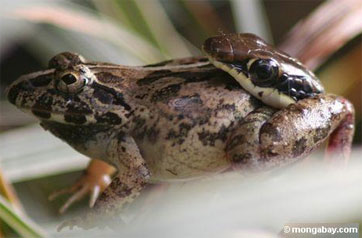Malaysia’s deforestation rate is accelerating faster than that of any other tropical country in the world, according to data from the United Nations. Analysis of figures from the Food and Agriculture Organization of the United Nations (FAO) shows that Malaysia’s annual deforestation rate jumped almost 86 percent between the 1990-2000 period and 2000-2005. In total, Malaysia lost an average of 140,200 hectares — 0.65 percent of its forest area — per year since 2000. Declining forest cover in Malaysia results primarily from urbanization, agricultural fires, and forest conversion for oil-palm plantations and other forms of agriculture.
Despite these losses, Malaysia has some spectacular protected areas including Taman Negara — Malaysia’s largest and best-known national park. Spanning 4343 square kilometers, the park is home to some of southeast Asia’s rarest creatures including tigers, the Malaysian tapir, forest elephants, and the Sumatran rhino.
Scientists believe that the rainforest of Taman Negara may be the oldest on Earth. Untouched by glaciers during recent ice ages, Taman Negara forests have remained largely the same for some 130 million years — for comparison, the rainforests of the Amazon as we would recognize them are probably less than ten million years old. Their stability means these forests are some of the most diverse on the planet. More than 350 species of birds, 14000 species of plants, and 210 species of mammals can be found in the forests of Taman Negara.
 Frog lunch for a snake in Taman Negara. Photo by R. Butler |
Due to the park’s relative proximity to Kuala Lumpur, Malaysia’s bustling capital city, Taman Negara is a popular destination for both local and foreign tourists, drawing more than 100,000 people annually. On weekends during the summer high season, trails around the entrance of the park can become quite crowded and the waiting period for the canopy walkway may exceed two hours. Nevertheless, with its well-developed trail system, it is always possible to escape the crowds and find solitude in the pristine forests. Adventurous travelers can try climbing Gunung Tahan, the highest peak in Peninsular Malaysia, located 55 kilometers from the main park entrance. Other options include overnight trips to wildlife observation hides, river trips to refreshing waterfalls, cave “exploration”, and visits to Orang Asli — forest people — settlements.
Tours to Taman Negara are easily arranged out of Kuala Lumpur or through Internet operators and there are a variety of lodging options near the park’s entrance. Once in the park, you can hike on your own or make arrangements with local guides, who may help you see some of the forest’s more elusive creatures. Remember that hiring a local guide brings direct benefits to the community that lives around the Taman Negara. Conservation works best when it proves economically viable for local people.